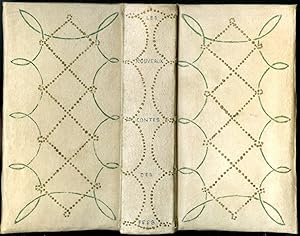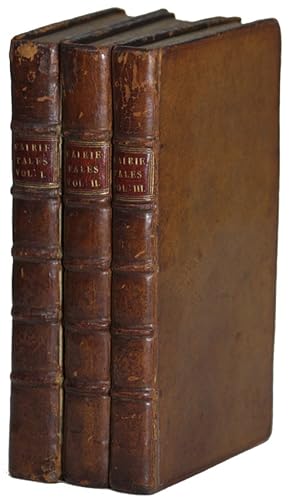AULNOY, COUNTESS D' MARIE CATHERINE LE JUMEL DE BARNEVILLE, BARONESS D'AULNOY (2 résultats)
Type d'article
- Tous les types d'articles
- Livres (2)
- Magazines & Périodiques
- Bandes dessinées
- Partitions de musique
- Art, Affiches et Gravures
- Photographies
- Cartes
-
Manuscrits &
Papiers anciens
Etat
- Tous
- Neuf
- Ancien ou d'occasion
Reliure
- Toutes
- Couverture rigide
- Couverture souple
Particularités
- Edition originale
- Signé
- Jaquette
- Avec images
- Sans impression à la demande
Pays
Evaluation du vendeur
-
Nouveaux Contes des Fées. Par Madame D * *
Edité par Chez Meindert Uytwerf, The Hague, 1700
Vendeur : Pazzo Books, Boston, MA, Etats-Unis
Hardcover (Vellum). Etat : Near Fine Condition. Early Edition. Modern full decorated parchment, page edges decorated in green, white and gold - a charming rebinding. Occasional browning and wear to page edges, slight foxing in spots, but bright and clean overall. Two volumes bound in one each with a title page and frontis (the same frontis of a woman storyteller dressed as Minerva reading to a Salon group). Aulnoy's first collections were published in 1698 in Paris, Les Contes de Fées and then Noiveaux Contes des Fées (quickly pirated with a Trevoux imprint) and then in The Hague in 1698 and again in 1700 by Uytwerf. This edition, confusingly, collects the latter two volumes of the original Les Contes de Fées. All the early editions are represented by just a few copies in libraries and auction records. Included here are Le Nain Jaune and Le Mouton both collected in Lang's Blue Fairy Book, and Finette cendron, a Cinderella/Wonderful Birch type tale. (4), 244, (4), 210pp. Married to a 40+ gambler when she was only 13, she tried to have him killed, failed, did a short stint in prison, and then traveled widely through England and Spain while working as a spy. She returned to Paris in 1690, opened a Salon, and wrote a series of extremely successful fairy tales in a conversational Salon style. Folktale historian Jack Zipes describes her as "more notable" than Perrault. Like madame de Villeneuve who followed in her footsteps, Aulnoy empowers women in her stories and critiques the French upper class society hat sought to oppress and belittle independent women. She coined the term fairy tale and wrote a number of tales that are read today - though many filtered through Andrew Lang. A new collection of her stories, The Island of Happiness, is scheduled to be published by Princeton in April 2021 and includes The Green Serpent from this collection. Size: Octavo (8vo). Quantity Available: 1. Shipped Weight: Under 1 kilo. Category: Literature & Literary; Inventory No: 047112.
-
A COLLECTION OF NOVELS AND TALES OF THE FAIRIES. Written by That Celebrated Wit of France, the Countess d'Anois. In Three Volumes . The Third Edition. Translated from the Best Edition of Original French, by Several Hands
Edité par Printed for J. Brotherton and W. Meadows in Cornhill; R. Ware in Amen Corner; T. Astley in St Paul's Church Yard; and J. Hodges on London Bridge, London, 1737
Vendeur : Currey, L.W. Inc. ABAA/ILAB, Elizabethtown, NY, Etats-Unis
Small 12mo, three volumes: pp. [1-2] [i-ii] iii-ix [x] [1] 2-288; [1-3] 4-275 [276: ad]; [1-3] 4-239 [240: ad], eighteenth-century full brown calf, gauffered edges, red morocco title pieces. Third edition. A collection of twenty-six literary fairy tales: eleven by d'Aulnoy (eight tales plus three nouvelles used to frame them); four by the comtesse de Murat; the remainder (all in volume three) by Louise de Bossigny, comtesse d'Auneuil. As Nancy and Melvin Palmer have shown ("English Editions of French Contes de Fees Attributed to Mme D'Aulnoy," Studies in Bibliography, Vol. 27 [1974]), the subject of French fairy tales in English in the seventeenth, eighteenth, even into the nineteenth century, is "fraught with bibliographical confusion," including unattributed and misattributed work, variant spellings of names, and the coincidental similarity of different names. The 1691 appearance of d'Aulnoy's tale "The History of Adolphus" can now be seen as starting the whole English vogue for French literary fairy tales, but it appeared without correct attribution and was until recently thought to be an original English work. Eighteen of her stories appeared in English before the nineteenth century, the most by any French author; but twenty-eight other stories attributed to her were in fact written by four others. Furthermore, the 1699 edition of d'Aulnoy's tales listed by Arundel Esdaile is regarded today as a bibliographical ghost. D'Aulnoy is, at the very least, an equal of Fénelon and Perrault. Terry Windling, in an excellent essay tracing the development of this form ("Les Contes des Fees: The Literary Fairy Tales of France"), writes that "a passion for conversational parlor games based on the plots of old folk tales swept through the salons [of seventeenth-century France] . and a style emerged that was both archly sophisticated and faux-naif." "Unlike her contemporary, Charles Perrault (a frequent visitor to her salons), who only occasionally used his fairy tales for purposes of satire, she made that her prime motive, with the result that, unlike Perrault's, her tales were composed primarily for adults -- and were thus among the first literary fairy tales . Although less known now, her stories contain all the basic plot devices of fantasy, and were highly influential in their day . Her stories are usually much longer narrative constructions than the fairy tales by Perrault or the Grimm Brothers, and this fact has made them less memorable, despite their position among the earliest original fantasies. It was, however, with the translation of a few of her stories into English as TALES OF THE FAIRIES (1699), that the term 'fairy tales' passed into the language." - Clute and Grant (eds), The Encyclopedia of Fantasy (1997), p. 72. ESTC N28398 (Edinburgh University Library, National Library of Wales, Harvard University, New York University). Previous owner's bookplates affixed to front paste-downs. Front joint of volume one repaired, corners and edges a bit rubbed and bumped but overall a very attractive copy. Enclosed in a custom quarter leather clamshell box. (#137511).



